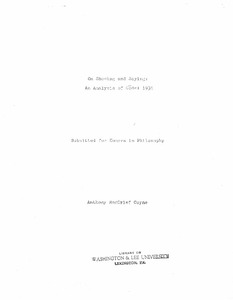| dc.rights.license | In Copyright | en_US |
| dc.creator | Coyne, Anthony MonCrief | |
| dc.date.accessioned | 2023-10-20T15:49:38Z | |
| dc.date.available | 2023-10-20T15:49:38Z | |
| dc.date.created | 1970 | |
| dc.identifier | WLURG038_Coyne_thesis_1970 | |
| dc.identifier.uri | https://dspace.wlu.edu/handle/11021/36290 | |
| dc.description.abstract | In 1931 Kurt Go?del published a theorem demonstrating that many systems of formal logic capable of developing arithmetic possess major deficiencies. He shovs that such systems, if they are consistent, are powerless to demonstrate their own consistency and possess propositions which can neither be proven nor disproven. In order for his results to obtain, Godel must use the language of his system to talk of itself. To avoid difficulties such as those which develop in Richard 's paradox, Go?del must take care to insure his formal language refers only to numbers. The reader must then see this discussion
as one about the system itself. From the consideration of this kind of language reference which keeps Go?del free from paradox, a general criterion for detecting paradoxical reference in language will be offered. Traditional approaches to Go?del's work concern themselves with its relationship to the program of Hilbert for mathematics. Thus Jean Ladriere in his study Limitations Internes des Formalismes examines the capacity of any formal system to embody mathematics in its entirety. The concern is mathematical. The concern of this paper is with language used for reference to objects (of some sort) beyond the language itself. Mathematical considerations, other than the proof itself, will be kept at a minimun. One side issue has appeared in examining Go?del's theorem deserving more attention than it has heretofore received. In his proof Go?del allows for expanding the scope of his system by allowing the inclusion of additional assumptions. In Chapter 3 the question of whether these postulates
may be of empirical origin will be considered. Chapter 2 of this paper is an exposition of the work of Kurt Go?del in his 1931 paper. It presents all of the technical devices used for the final result, omitting only proofs for some of the intermediate theorems which are of little interest in themselves. Chapter 3 develops Richard's paradox of 1905 along his original lines. It goes on to present the paradox as given by Nagel and Newman and to develop the error which permits the paradox. . . . Finally Chaper 4 will explore a generalization of the solution of Richard 's paradox for ordinary language. It will be shown that many traditional antinomies can be detected using this criterion. [From introductory section] | en_US |
| dc.format.extent | 76 pages | en_US |
| dc.language.iso | en_US | en_US |
| dc.rights | This material is made available for use in research, teaching, and private study, pursuant to U.S. Copyright law. The user assumes full responsibility for any use of the materials, including but not limited to, infringement of copyright and publication rights of reproduced materials. Any materials used should be fully credited with the source. | en_US |
| dc.rights.uri | http://rightsstatements.org/vocab/InC/1.0/ | en_US |
| dc.subject.other | Washington and Lee University -- Honors in Philosophy | en_US |
| dc.title | On Showing and Saying: An Analysis of Go?del 1931 | en_US |
| dc.type | Text | en_US |
| dcterms.isPartOf | WLURG038 - Student Papers | en_US |
| dc.rights.holder | Coyne, Anthony MonCrief | en_US |
| dc.subject.fast | Go?del, Kurt | en_US |
| dc.subject.fast | Philosophy -- Mathematical models | en_US |
| local.department | Philosophy | en_US |
